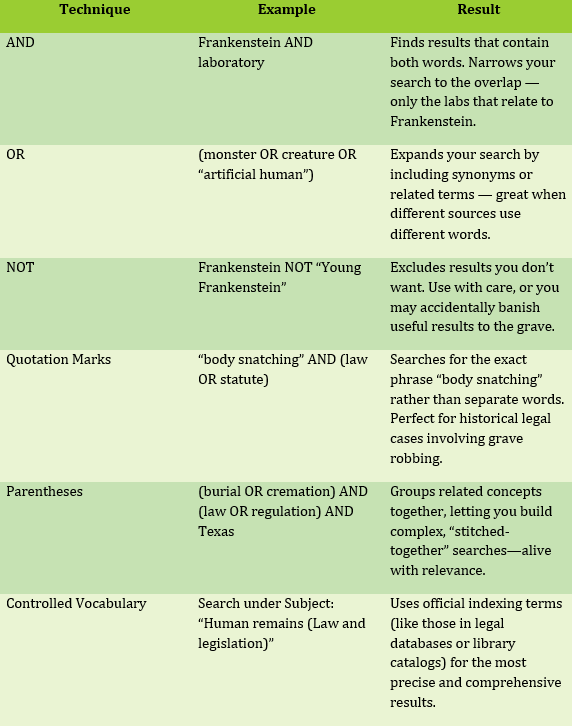Natural Language Searching—also known as Plain Language Searching or Free Text Searching—is the way most of us instinctively interact with search engines. It’s unstructured, intuitive, and based on how we naturally think and speak. We might type a full question, such as:
What does Texas law say about the proper burial of human remains?
Or, when we’re short on time, we might enter something more like:
law health burial
That’s natural language searching at work—more folksonomy than taxonomy, more instinct than structure. It’s a perfectly acceptable way to begin your research journey, but it’s also a bit unrefined. Constructing more sophisticated queries is the key to developing competence as an expert researcher. Let’s explore the evolution of search—progressing from plain to proficient—through the transformation of Mary Shelley’s Modern Prometheus, aka, Frankenstein's Monster.
The Monster Learns to Speak
Hollywood’s many interpretations of Ms. Shelley’s 1818 novel (which is in the public domain at Project Gutenberg) depict the Monster as primitive and inarticulate; they often cut the story short, never exploring his full transformation from grotesque and crude to elegant, sensitive, thoughtful, and refined.
Conceived in the imagination of a mad scientist, Victor Frankenstein, the Monster develops not only fluency but also astonishing eloquence. This pseudo-human creature becomes quite adept with language, learning to speak multiple foreign tongues. At one point in his evolution, alone and longing for connection, the Monster delivers a stirring soliloquy on the nature of man's yearning with all the poetry and polish of a well-educated orator. As the creature himself declares in one of his most moving monologues:
“I, the miserable and the abandoned, am an abortion, to be spurned at, and kicked, and trampled on. Yet even the enemy of God and man had friends and associates in his desolation; I am alone.”
— Mary Shelley, Frankenstein (1818)
It’s a haunting passage—and a reminder that even something born of chaos can evolve into something articulate and profound.
From Grunts to Grammar: The Searcher’s Evolution
Much like Frankenstein’s Monster, every researcher begins with a kind of linguistic infancy—punching in a few keywords, seeing what comes up, and hoping for the best. This is the “fire bad” stage of searching: simple, direct, but often imprecise.
Then comes the next phase—the learning, the refinement, the humanizing process. As we grow more skilled, we start using controlled vocabularies (like Library of Congress Subject Headings or legal indexing terms), Boolean operators (AND, OR, NOT), and Terms & Connectors to sculpt our queries with precision. We might even engage with AI-powered tools or Large Language Models that can parse meaning, context, and nuance—much like Shelley’s creature learning to manipulate words and master the expression of complex human emotion. This increases the specificity and relevance of our results, and we exclaim: “It’s alive. It’s ALIVE!” The feeling can be electric!
In short: Natural Language Searching can be compared to the Monster's early speech patterns with single or few word utterances. More advanced search constructions, however, are the designs of a more careful creature—Frankenstein's Monster as a more fully-realized human. Plain Language searching is acceptable—and sometimes preferred—and it generally helps us find what we want, but to really develop our chops as an expert level searcher—a refined monster like Dr. Frankenstein's fully evolved creation—we would do well to learn a few tips and tricks to really excel. Follow the examples below to really bring your search experiments to life!
From Rough to Refined
Plain Language Search = law health burial vs. Refined Search = (burial OR disposition) AND (human remains OR corpse) AND Texas
Plain Language Search = fire bad vs. Refined Search = (fire OR arson OR “burning building”) AND (hazard OR damage OR “public safety”) NOT “campfire”
Want to Search like a Scientist?
Try combining Boolean operators and controlled terms to give your searches structure, precision, and power. See below.



